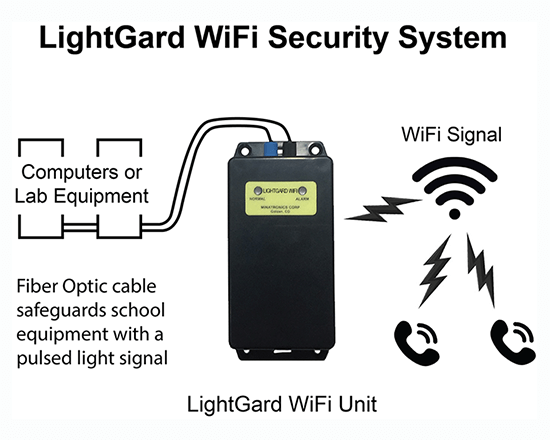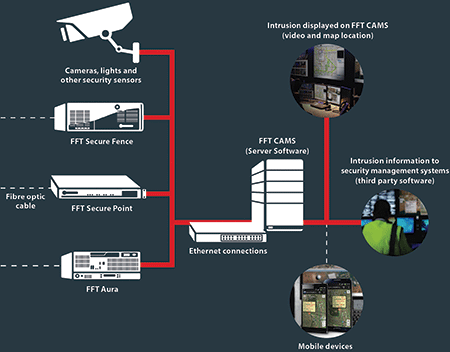The Role of Fiber Security in Enhancing Your Cyber and On-Site Security Network
The Role of Fiber Security in Enhancing Your Cyber and On-Site Security Network
Blog Article
Why Fiber Optic Safety And Security Equipments Are the Future of Security
The transition to fiber optic protection systems notes a considerable development in the world of defense, driven by their exceptional information transmission abilities and strength to outside disturbances. These systems not only facilitate faster and extra reputable interaction however additionally present a cost-efficient solution with lowered maintenance demands. As the landscape of security progresses along with emerging technologies such as AI and IoT, the capacity for optical fiber to enhance and redefine safety frameworks becomes progressively apparent. Nevertheless, the effects of these advancements raise important questions regarding the future of safety steps and their performance in an ever-changing setting.
Benefits of Fiber Optic Equipments
Among the main advantages of fiber optic systems is their premium data transfer capacity, which facilitates the transmission of large quantities of information over long ranges without considerable loss. This particular is especially advantageous for protection applications that need the continual monitoring and transfer of high-definition video clip feeds, sensing unit data, and various other essential info. Fiber optics can accommodate the expanding needs of modern security systems, making certain that information continues to be intact and dependable.
Additionally, fiber optic wires are less susceptible to electromagnetic interference, which can be a substantial problem in environments with numerous electronic tools. This resistance enhances the honesty of the data being sent, thus minimizing the threat of data breaches or system failings. Moreover, fiber optic systems are inherently a lot more secure than standard copper wires, as using a fiber optic line without detection is extremely difficult.
The resilience of fiber optic wires also adds to their allure. They are resistant to ecological aspects such as moisture and temperature changes, reducing maintenance expenses and boosting system longevity. In general, these benefits placement fiber optic systems as a durable and efficient option for modern protection infrastructures, guaranteeing trusted and secure data transmission.
Boosted Data Transmission Speed

The ability to transfer vast amounts of data swiftly facilitates the seamless assimilation of high-definition video clip feeds and advanced analytics. Security systems can now refine and analyze info in real-time, enhancing action times and situational awareness. Furthermore, fiber optic connections sustain longer transmission ranges without destruction of signal top quality, making them suitable for large safety and security networks.
The increased rate of fiber optic systems not just enhances the efficiency of safety and security procedures yet also reduces latency. This is particularly crucial in important circumstances where prompt decision-making can prevent protection breaches or mitigate prospective threats. As organizations remain to prioritize safety and security and performance, the demand for rapid and trusted data transmission Click This Link will certainly solidify fiber optic systems as a cornerstone of contemporary security infrastructure.
Resistance to Disturbance
Fiber optic protection systems continually show extraordinary resistance to electromagnetic disturbance, a crucial benefit in atmospheres vulnerable to digital noise. Unlike standard copper wires, which can be negatively impacted by electro-magnetic areas, radio frequency disturbance, and various other forms of electrical disturbance, fiber optic wires use light to transfer information. This inherent home makes certain that the signals continue to be clear and unaltered, regardless of surrounding electronic task.
Making use of glass or plastic fibers in fiber optic innovation produces an obstacle versus interference, enabling for trusted data transmission also in challenging scenarios such as commercial centers, urban locations with high electronic web traffic, or places near radio towers. This particular significantly decreases the likelihood of signal degradation or loss, making fiber optic systems particularly ideal for safety and security applications where stability and precision of information are extremely important.
Additionally, this resistance to disturbance enhances the general efficiency and reliability of safety and security systems, guaranteeing that tracking and alert systems work flawlessly. In a world where safety and security is significantly intimidated by innovative innovations, the strength of fiber optic systems sticks out as a critical attribute, reinforcing their status as an essential element of contemporary security framework.
Cost-Effectiveness With Time
Significant expense savings can be accomplished with time with the execution of fiber optic safety systems. While the first investment might seem higher compared to standard copper-based systems, the long-term monetary benefits emerge through reduced functional and upkeep expenses (fiber security). Fiber optic cable televisions are inherently extra durable and less susceptible to environmental elements, which equates site link to reduce substitute and repair work costs over their lifespan
Additionally, fiber optic systems call for much less power to run, which further decreases power prices. Boosted information transmission abilities permit for fewer repeaters and amplifiers, minimizing equipment investment and improving installation procedures. The scalability of these systems additionally adds to cost-effectiveness, as organizations can increase their security facilities without sustaining significant extra costs.
An additional element to take into consideration is the boosted efficiency in surveillance and response capabilities that optical fiber provide. Enhanced real-time data transmission can result in quicker incident reaction times, potentially mitigating losses and obligations connected with safety and security breaches. In amount, the lasting benefits of fiber optic security systems not only validate the initial expenditure but likewise place them as an economically sensible option for organizations seeking durable defense remedies.

Future Technologies in Safety
Progressing technologies are established to transform security systems, integrating fabricated knowledge (AI) and artificial intelligence to improve hazard detection and reaction abilities. These technologies will certainly permit safety systems to evaluate substantial quantities of data in real-time, recognizing patterns and abnormalities that indicate prospective risks. This this page aggressive technique will allow quicker decision-making and much more effective event actions.
In addition, the consolidation of the Internet of Things (IoT) is leading the way for interconnected safety tools, providing extensive monitoring and surveillance. Smart sensors can communicate information concerning environmental changes, while automated signals can notify safety employees quickly of questionable activities.
Furthermore, the development of biometric innovations will better bolster safety and security mechanisms. Face recognition, finger print scanning, and retina recognition are becoming much more advanced, supplying layers of authentication that are difficult to bypass.
Final Thought
In final thought, fiber optic safety systems stand for a considerable development in protection modern technology, providing unequaled data transmission rate, resistance to electromagnetic disturbance, and long-term cost-effectiveness. As the demand for innovative protection options remains to grow, the assimilation of optical fiber with emerging modern technologies such as AI, IoT, and biometrics will further boost security infrastructures (fiber security). The mix of these advancements will certainly guarantee a much more safe and receptive environment, strengthening optical fiber as a cornerstone of future safety and security systems
Report this page